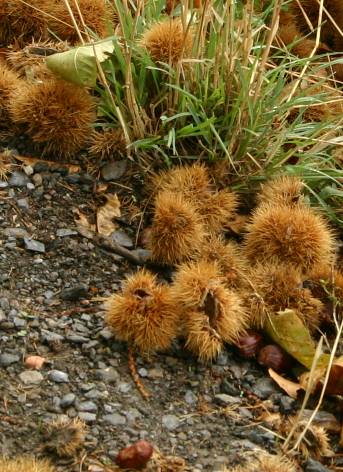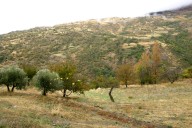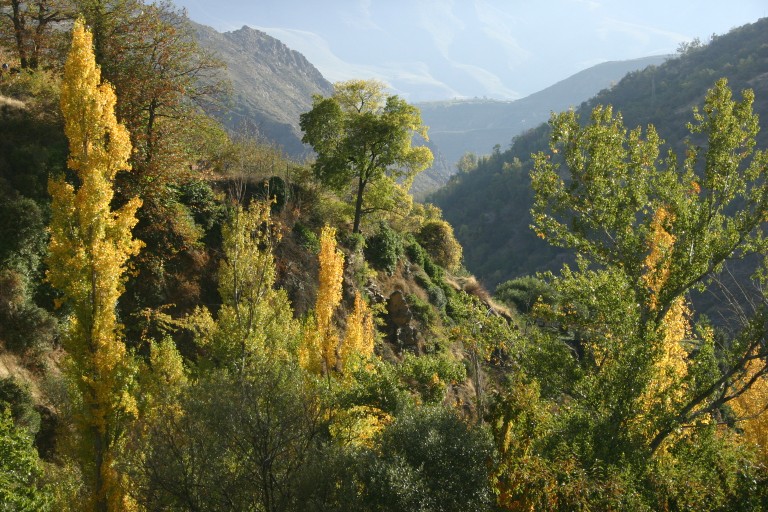
many still in their husks, everywhere





|
|
This day, we saw chestnuts,
many still in their husks, everywhere |
On this day, we were scheduled to do the longest and most demanding walk of the trip. We would start out from our hotel in Bubión, and descend into a ravine nearby, then up the other side, have our lunch at the Buddhist Study Center there, then return by the same route. We started out at about nine, and the weather was fairly raw and gray. As a result, the pictures we took from morning till the sun finally broke out in mid afternoon lack spark. I have shamelessly, but I hope not excessively, augmented the contrast to brighten up the colors on many of the ones you see on this page.

We walked through countryside that has been cultivated for not just centuries but millennia. The Romans apparently introduced the chestnut tree to Spain, and there were plenty of them about, and the ground was in places covered densely with chestnut burrs, some still containing the nuts, others empty. At the top of the page, you can see one nut down at the very bottom, and two nestling by a leaf towards the right side of the picture.
Another tree we saw many of was cherry. These too are agriculturally underutilized—Nick and Bruno told us that the European Union agricultural rules penalize smaller countries like Spain, to the benefit of France; in particular, it just doesn’t pay to harvest the chestnuts and cherries from a region like the one we were walking through. But we certainly saw plenty of cherry pits on the ground, in addition to the chestnuts. We walked in open landscape like the first picture to the right (small image; large) before starting to descend into the ravine. But once we got into the really mountainous terrain, the sights became much more interesting. In the picture to the left (small image; large), we’re looking down into Pampaneira, the lowest of the three villages we visited or stayed in in this area. The highest was Capileira, which we walked to and shopped in on the next day, and the middle was our base, Bubión.
As we walked, the weather got foggier and drizzlier. In the next picture to the right (small image; large), I am in the rear guard as usual, and most of the people up front are unrecognizable, except for Janet Bank directly ahead, and Rita Bamberger at the left of the knot of people there. I like this picture particularly well, for its nice atmospheric quality.
Some time in the mid to late morning we stopped in at the cot of a farmer named Enrique, whom Nick has known for some time. Mark has several pictures, but for some reason I did not pull my camera out—maybe because of the weather. For much of the morning, it was alternating between rain and drizzle. But at just about noon, we paused for snacks. As I recall, we all had trail mix with us, but Bruno pulled some very nice chocolate out of his pack, and shared it with everyone. Much better than trail mix! The picture at the left (small image; large) shows Bruno holding a block of chocolate; to the left of him is Cindy Powser, while directly behind Bruno you can see Mark’s sweatband, and then, to the right, you see Caroline Leggette, Joel Shore, Shelton Bank, Rita, Janet, and with his back to us, Ralph Weston.
The very next time I snapped a picture it was almost two hours later, when we paused again at a Buddhist stupa associated with the retreat, or Study Center, where we would be having lunch. One of the guides said that you could improve your karma by walking a certain number of times around the structure, which you see some of our group doing (small image; large). I think that I must have been feeling grumpy or at least unimpressionable, because I held back from doing the circuit. Maybe I felt that my karma was just fine, thank you. You see that the prescribed direction for doing the circuit is clockwise, or I suppose more properly sunwise. Isn’t going around something “widdershins” supposed to be bad luck or likely to induce evil in some Western folklore as well?
We soon continued on, and in about half an hour or so, we got to the Center proper. Nick explained to us that since there were people in little cabins meditating, the folks in charge asked that we speak at the lowest possible level, so as not to disturb them. We put our things down by a huge prayer wheel, which was for some time the biggest such in the world. Again, it was supposed to be good for your karma to help the thing along, and again sunwards only. Under no circumstance was one to turn it counterclockwise! I think I relented enough to give the thing a little nudge. As you can see, it's of hammered copper, with some very nice-looking messages in (I presume) Sanskrit up top, in (again, I presume) Devanagari script. But as someone who has worried about typography and fonts, I hafta say that I was offended by the form of the capital Latin letters that you see so prominent in the middle rank. That I is just too fat! Anyway, much more interestingly, you see Deena Mazer chatting with Mark up front, and between them a few feet back are Nadji and Oakley Reynolds. (Small image; large)
Before leaving the Center’s precinct, we stopped in at a house—a bit roomier than the meditators’ cabins, which served as the kitchen for the Center, and which was under the care of a very pleasant lady named Isabel who was very generous with her time and her supplies, offering us tea, coffee, biscuits, and honey. It was a nice way to bid our farewells to the Center, and all of us were very grateful to her for her kindness.
Soon we were on our way back, just the way we had come. The Study Center was a few hundred meters higher than our starting-out point in Bubión, but we had to go all the way down the ravine and then back up to get to our hotel. So in some sense, the return trip should be less demanding than the trip out. But the steepest part of the ravine was in the part closer to our home base, so the toughest segment of the hike was the last one, on the way back up the hill to Bubión. Mark said afterwards that he found that part particularly challenging; but it didn’t seem to bother me all that much.
Be that as it may, the weather improved greatly as we went along: at first, the sun peeked through the clouds occasiolly, and then we had some nice relief showing in the views we got of the oppoite side of the ravine, as you can see in the upper-left photo of the four at the right (small image; large). In the upper right snapshot there (small image; large) we’re looking out in a different direction, and you can see the nice photo-enhancing haze that was left after the damp weather that we had endured earlier. In the pictures of the lower row (left: small image, large; right: small image, large), we’re looking out in sunny weather down to some of the pueblos blancos (“white towns”) that this region has made itself renowned for.
We descended into the ravine, farther and farther down, finally got to the bridge over the stream running at the bottom. The picture at the left (small image; large) shows how we straggled in, with Mark and Jonathan in the rear guard, of course. After we got settled, with our water bottles out and a generous portion of chocolate doled out by Bruno, we could chat, as Nick and Oakley did (small image; large), or just take the luxury of exhaustion, as Mark did (small image; large). In this last picture, you see Rita, then Teague Gilliland standing and talking to Caroline, and between them in the distance is Nadji, while Bruno is at the extreme right.
And then the climb up. Mark said afterwards that he thought that with our previous exertion, this was a very tough one. It didn’t bother me that much—you just put one foot in front of the next, after all. But with the sun’s breaking through, I got a couple of really nice shots. In particular, the one at the top of the index page, which I duplicate below.
We got to our hotel room around seven, and showered and changed for supper. The restaurant, “Estación Cuatro” was very good. We had specified in the morning what dishes we wanted. I had said “casseroled lamb”, while Mark had chosen minced lamb burgers. Mine turned out to be a very nice lamb stew, plenty of onions and enough raisins to sweeten it significantly but not unpleasantly, and Mark’s, when I sampled it, was really nice. Both came with couscous, just the right accompaniment. Of course there had been salads beforehand, but augmented with baba ganoush and tabouleh, both very welcome. For dessert, there were several choices. We thought that the lemon cream would be least heavy, and it was very good, but generous and sweet enough that we both left half the dish. Tasting the cheese cake, though, which looked like a regular New York-style dish, we realized that we had not made the very best choice: the cake was light and airy, neither too sweet nor too rich.
And thence to bed, where I expected to sleep soundly, in preparation for another walk in this dramatic countryside.

Go to the next day’s page; to the previous day’s page.
Return to the Spain index page; to my main page.